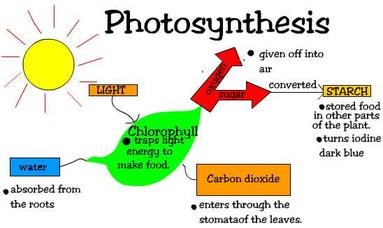Chlorophyll photosynthesis is an essential biochemical process vital to the survival and health of the plant itself. It is precisely through photosynthesis that plants get the food they need to grow. The basis and engine of the entire process is chlorophyll, a green pigment on the leaf’s surface. Chlorophyll captures the sun’s energy and converts it into chemical energy. This energy generated by the photosynthesis process used to convert the carbon dioxide absorbed from the air into sugar and carbohydrates, which the staple foods for feeding the plants. During the photosynthesis phenomenon, chlorophyll produced as a waste of the whole process. It free of oxygen, which an essential element for the life of plants, animals, and of course, for humans on earth. If you need to understand What are the products of photosynthesis, you are in the right place.
Table of Contents
But What are the products of photosynthesis? – Process scheme and stages
The process of chlorophyll photosynthesis occurs in two primary phases: the light and the dark phase. The first generates energy in ATP, while the second phase – also identified by the name of the Calvin cycle – enables the conversion of inorganic carbon (carbon dioxide) into organic carbon molecules (or glucose).
Let’s see in detail what these two stages of the photosynthetic process involve.
The absorbed energy is stored in two chemical compounds, ATP and NADPH2. These two compounds deal with the storage and transfer of power to the different parts of the plant. ATP is the energy transporter that drives reactions to produce carbohydrates and other metabolic functions. NADPH2, on the other hand, transfers electrons, generally hydrogen, for the synthesis of carbohydrates and other components.
LIGHT = ATP + NADPH2
The essential components for the photosynthesis of carbohydrates (CH2O) come from carbon dioxide (C02) and water (H2O). Carbon dioxide is found in the air or can be administered using special dispensers. Since this is a biochemical process, to better understand chlorophyll photosynthesis, it is necessary to see the relative chemical formula:
CO2 + H 2 O = (CH 2 O) n + O 2
What is chlorophyll photosynthesis used for? The role of glucose and oxygen
The glucose naturally produced by plants during this process is a fundamental compound. It enables the high-energy molecules to synthesized and the energy required to carry out the plant’s metabolic process to released. Therefore, the process of chlorophyll photosynthesis used by plants to produce the substances and nutrients necessary for their life and growth.
Oxygen, on the other hand, which released as waste during the process, essential for the life of all living things on earth. The carbon dioxide present in the environment converted into valuable oxygen thanks to the chlorophyll photosynthesis process carried out by plants. This process fundamental to the life of the plant and of vital importance to humans and their health. Because by converting carbon dioxide into oxygen, the plants indirectly contribute to the fight against pollution. They transfer the excess carbon dioxide from the anhydrite absorb now in our cities and contain the smog present in the air.
Most important part
On the other hand, the fate of sugar is related to the ability of the plant cells to put it in the form of starch and then use it as an energy source for their vital activities (breathing). Ultimately, the photosynthesis process rightly seen as the link between two worlds, the living and the non-living.
Indeed, by observing the chemical reaction that guides the process, it becomes clear how the meeting of two inorganic substances with the sole contribution of solar radiation creates an organic sense, sugar, the part of plants’ living tissue becomes chlorophyll photosynthesis.
It must be emphasized that only green vegetables are responsible for sustaining life in any environment. They capture this immense energy source, namely sunlight, which without these receptors would be distributed in space.
Final word: What are the products of photosynthesis
Photosystem I also reached by solar energy. The reactive chlorophyll center loses an electron; This goes to the chain of electron carriers of the photosystem. I, the last acceptor of an NADP (nicotinamide adenine dinucleotide phosphate). Each NADP + molecule binds to two electrons and one hydrogen ion (from the dissociation of water) and forms NADPH, an energy-rich transporter. The confusion on What are the products of photosynthesis cleared. If you have any asks, let us know via email or comment on us on the blog.
